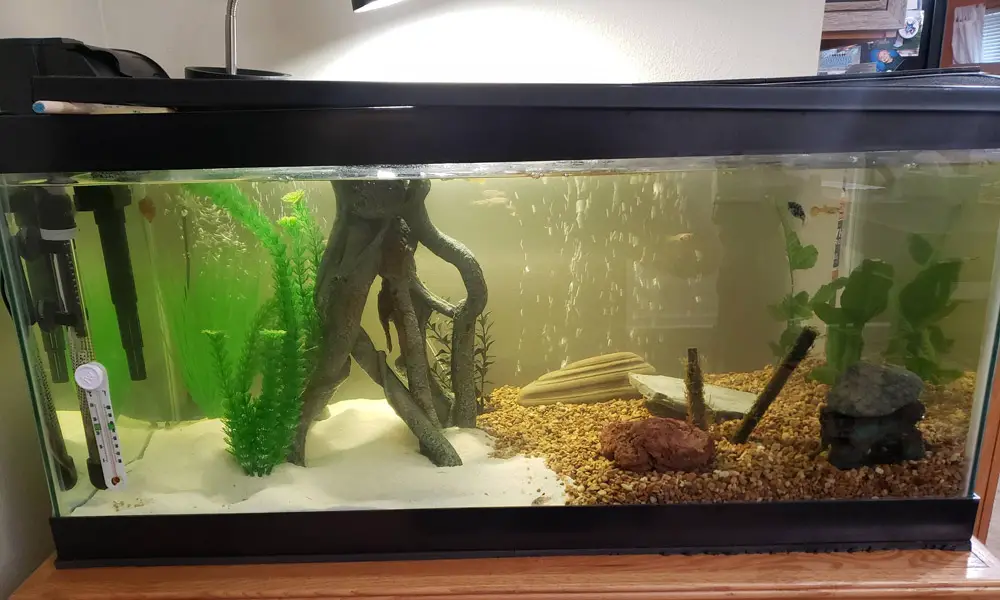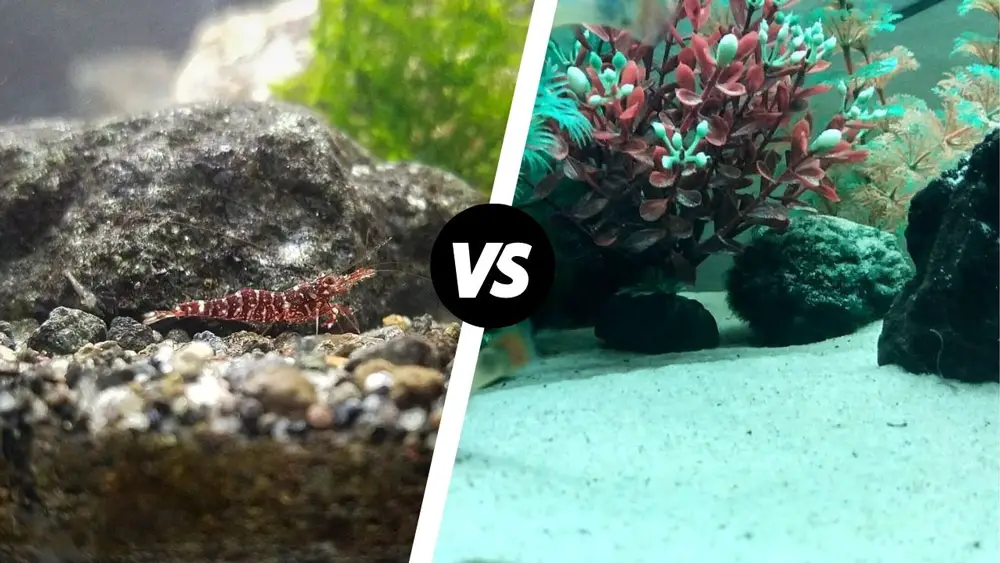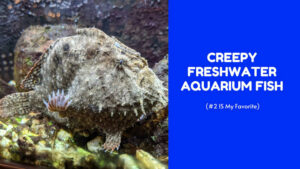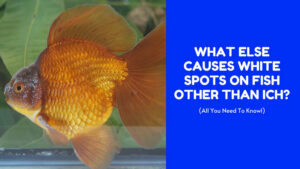As an ardent aquarium enthusiast, you may have this wild thought that you’re not sure if it’s realistic or not. You’ve wondered whether it’s possible to have a half gravel half sand aquarium, right?
You like the idea, but at the same time, you want to ensure that you’re not doing anything that will compromise the health of the plants and fish in the aquarium.
In this post, I’ll help you know what’s the best way to choose the ideal substrate for your aquarium. You’ll learn the pros and cons of each substrate so that you know which to choose and why.
Let’s get your questions sorted.
Can You Mix Half Sand and Half Gravel in An Aquarium?
Yes, but I would not recommend it. Here’s why. First, sand is denser and so will sink to the bottom, leaving gravel to settle at the top. It’s time consuming to clean and change the water in an aquarium with a mixture of sand and water substrate. Also, certain species of fish, such as pleco and cichlids, that like digging, won’t do well in such an environment.
Pros and Cons of Mixing Half Sand and Half Gravel Substrate
Now that you know that it’s not advisable to mix half gravel and half sand in an aquarium, what are the benefits and drawbacks of using each type of substrate?
Aesthetic

The biggest advantage of mixing half gravel and half sand as a substrate in an aquarium is its aesthetic look. It simulates what a natural riverbed looks like with these two elements, so you can create a beautiful landscape while it lasts.
Also, if you have live plants in your aquarium, the roots will have something to grip onto and will grow well.
Apart from aesthetics, there aren’t any other benefits of mixing them as substrate. In fact, there are more disadvantages than advantages. Let’s take a look at those now.
Requires More Maintenance
The gravel and sand will eventually mix together, resulting in a genuine chore. You’ll have to spend a lot of time separating them, which is time-consuming and frustrating.
Unsafe for Certain Fish
But while this type of tank may be aesthetically pleasing, it can actually be quite dangerous for your fish. If you have fish that like to burrow or sift through the substrate, such as plecos, they won’t be able to do so on the gravel substrate.
In addition, the half gravel and half sand substrate will constantly get stirred up by your fish and never settle, which means your water quality will suffer, and your fish will be constantly stressed.
As a result, it’s important to do your research before setting up a half gravel and half sand aquarium. Otherwise, you might end up doing more.
To avoid all these problems, it’s best to choose one type of substrate and stick with it. If you want a gravel substrate, go for that. And if you want a sand substrate, make sure you get all sand.
Gravel Vs. Sand Aquarium Substrate
Let’s go over the pros and cons of gravel Vs. sand substrates used in the freshwater aquarium hobby.
| Gravel Substrate | Sand Substrate | |
|---|---|---|
| Pros | Affordable Different sizes, shapes and colors Heavy enough Insert | Affordable Different sizes and colors Debris stay on top Insert |
| Cons | Unwanted debris tends to get trapped Needs regular cleaning/vacuuming Sharp gravel can be harmful to bottom feeders Does not provide nutrients for plants | Easily gets kicked up into the water column Damage filters and pumps Not ideal for live plants Does not provide nutrients for plants Build up amoebas and bacteria easily |
| Best for | Preventing the buildup bacteria | Bottom feeders |
Pros and cons of Gravel Aquarium Substrates

Gravel is affordable and also readily available. Another reason that makes it popular is that you’ll find it in various shapes, colors, and sizes. Because the gravel is heavy enough, you don’t have to worry about your siphon or filter getting ruined.
One of the major cons of gravel is that you’ll often find debris trapped in the gravel. Unless you do regular spot checks, it might be hard to realize the existence of the unwanted debris.
Also, to maintain proper hygiene standards of your aquarium, you’ll have to do regular cleaning or vacuuming. Gravel doesn’t provide nutrients for live plants, and sharp gravel can threaten the bottom feeders.
In short, there’s no need to go against the rules of nature. While it might be a good experiment to try and see how it plays out, you already know the outcomes. There is no need to risk the comfort of your live plants, fish, and other critters.
You might be interested in reading: How Much Gravel for Fish Tank?
Pros and cons of Sand Aquarium Substrates
The advantage of sand is that it’s much finer and softer than gravel thus, it’s the best ideal substrate for soft-bellied fish and bottom-feeding fish. Additionally, the sand comes in a variety of sizes and colors, including light brown, black and white.
Another advantage of the sand substrate is that debris will always stay on top of the sand. From there, it will be easy for you to spot and remove them.
The downside to sand is that the fine granules make it easy for them to get stuck in the siphon if care isn’t taken during siphoning. Live plants tend to have a difficult time with sand substrates since it’s so dense that the roots of plants can’t easily spread out.
The sand substrate may also not be the best if you’re keeping live plants in your aquarium, as it doesn’t provide nutrients. Also, due to the compactness of the sand, it can easily form anaerobic areas in the aquarium that might end up releasing ammonia.
These two types of rocks will add visual interest and appeal to your aquarium: Lava Rock | Dragon Stone
How to Change Substrate From Gravel to Sand?
There are several ways to help you change your aquarium substrate from gravel to sand. But the first step is to determine whether you’re interested in partial or complete change.
For the partial change, you’ll need to start by rinsing your sand until the water running becomes clear. Next, remove ⅓ of the gravel inside the tank and replace it with the rinsed sand. Give it like a week and replace the remaining ⅓ gravel with rinsed sand.
It isn’t a must that you start by replacing ⅓ of the gravel. You alternatively do ¼ at a time but ⅓ should be the highest amount of gravel you replace at a time.
If you want to do a full change over, you might need to cycle the tank again. In that case, you’ll need to ensure the filter is off so that it doesn’t get spoiled.
Next, you’ll need to thoroughly rinse the sand before replacing it. Then, allow the sand time to settle.
Final Thoughts
By now, you’ve got all your questions and concerns settled, right? As you’ve seen, although it’s something that’s possible, having a half gravel half sand substrate is not just worth it. You’ll waste a lot of time during cleaning and changeover. Some fish species and critters may be at risk.
Eventually, the sand will settle at the bottom, so there will be no difference in having either of the two for a substrate. Instead, you convert that time into enjoying and caring for your aquarium.





